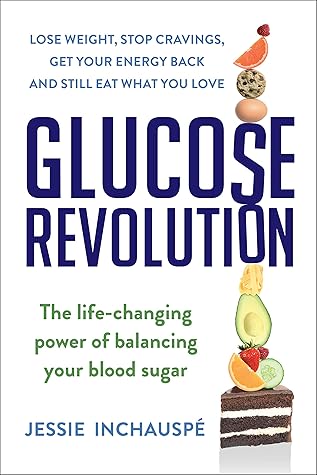More on this book
Community
Kindle Notes & Highlights
Read between
September 22 - September 23, 2025
do you know what the last thing you ate did to your body and mind?
although what we eat matters, how we eat it—in which order, combination, and grouping—matters, too.
Glucose is our body’s main source of energy. We get most of it from the food we eat, and it’s then carried in our bloodstream to our cells.
Regulating glucose is important for everyone, diabetes or no diabetes:
“Nothing matters—not school, not work, not money—nothing matters more than being healthy, physically and mentally.”
If our glucose levels are out of balance, dials flash and alarms go off. We put on weight, our hormones get out of whack, we feel tired, we crave sugar, our skin breaks out, our hearts suffer.
10 minutes of moderate physical activity after a meal reduces the glucose spike
although glucose is needed to fuel your body’s systems, fructose isn’t.
we eat a lot more sucrose (which, as a reminder, is half glucose, half fructose).
when we eat fiber, it remains fiber.
Starch, fiber, fructose, and sucrose
They’re all related, because they have the same parent, glucose—no
Carbohydrates = Starch and Fiber and Sugars (glucose, fructose, sucrose)
“carbohydrates” or “carbs,” I’ll be talking about starchy foods (potatoes, pasta, rice, bread, and so on) and sugary foods (fruit, pies, cakes, and more)
fiber is often removed in the creation of processed foods, because its presence is problematic if you’re trying to preserve things for a long time.
It’s because in Stone Age times the taste of sweetness signaled foods that were both safe (there are no foods that are both sweet and poisonous) and packed with energy.
table sugar—100 percent sucrose. This
it’s important to understand that the inclination to reach for a candy bar isn’t our fault. It’s not a willpower issue—far from it. Deep, old evolutionary programming tells us that eating Skittles is a good move.
fasting level, that is, your glucose level first thing in the morning before eating) between 60 and 100 mg/dL is “normal”; that between 100 and 126 mg/dL indicates prediabetes; and anything above 126 mg/dL indicates diabetes.
Why exactly are glucose spikes bad for us, and why are fructose spikes worse? What do they do inside our body?
Oxidative stress is a driver of heart disease, type 2 diabetes, cognitive decline, and general aging.
fructose increases oxidative stress even more than glucose alone. That’s one of the reasons that sweet foods (which contain fructose) are worse than starchy foods (which don’t).
When scientists look at the rib cage cartilage of babies, it’s white. Once a human reaches 90 years old, that same cartilage is brown.
browning happens when a glucose molecule bumps into another type of molecule.
Since browning is aging and aging is browning, slowing down the browning reaction in your body leads to a longer life.
Fructose molecules glycate things 10 times as fast as glucose,
The higher your HbA1c level, the more often the Maillard reaction is happening inside your body, the more glucose is circulating, and the faster you are aging.
The only thing that fructose can be stored as is fat.
if two foods have the same amount of calories, I’d recommend that you skip the sweet food (which contains fructose) in favor of a savory food (which doesn’t). The absence of fructose means that fewer molecules end up as fat.
If there is insulin present, our body is prevented from burning fat: insulin makes the route to our fat cells a one-way street: things can go in, but nothing can come out.
But if our glucose levels, and therefore our insulin levels, are steady, we shed pounds.
If you compare two meals that contain the same number of calories, the one that leads to a smaller glucose spike will keep you feeling full for longer.
constant hunger is a symptom of high insulin levels.
The more weight we put on, the hungrier we get.
A decrease in glucose levels—even a small decrease of 20 mg/dL, which is less than the 30 mg/dL dip that occurs after we spike—makes us crave high-calorie foods.
Flattening our glucose curve leads to fewer cravings.
lead to higher fatigue
A common symptom of dysregulated glucose is waking up suddenly in the middle of the night with a pounding heart.
you will be more susceptible to infection,
women experience symptoms from reduced libido to night sweats, insomnia, hot flashes, and more.
women with insulin resistance are twice as likely to have regular migraine headaches than women who don’t.
turns out that big glucose spikes can impair memory and cognitive function.
Flattening our glucose curves, along with exercising and reducing stress, is a potent way to prevent aging.
when there is excess glucose in our body, our brain is vulnerable to the consequences.
chronic inflammation is a key factor in almost all chronic degenerative diseases, including Alzheimer’s.
Alzheimer’s is sometimes called “type 3 diabetes” or “diabetes of the brain.”
Flattening glucose and insulin curves is thus an important step to helping prevent the development of cancer.
Your brain doesn’t have sensory nerves, so when something is wrong, it can’t alert you with pain as other organs do. Instead, you feel mental disturbances—such as poor mood.
people who adopt a glucose-flattening diet can get rid of their heartburn or acid reflux very quickly—sometimes within one day.
half the people who have a heart attack have normal levels of cholesterol.


